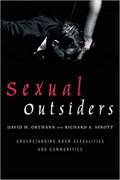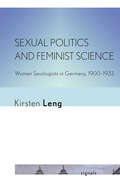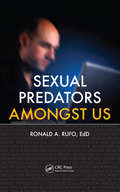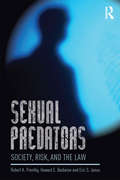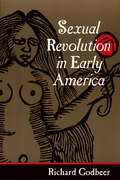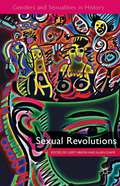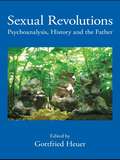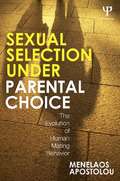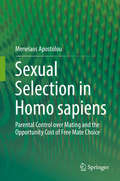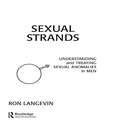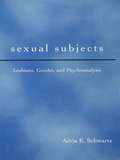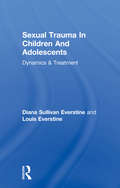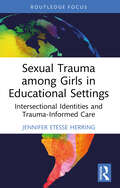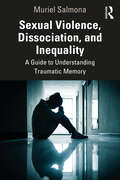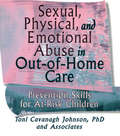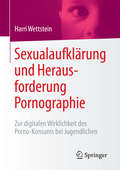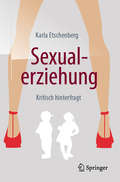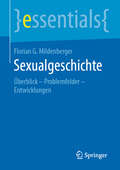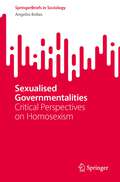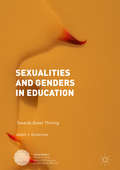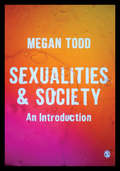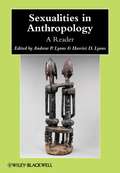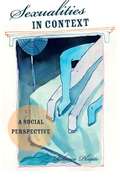- Table View
- List View
Sexual Outsiders: Understanding BDSM Sexualities and Communities
by David M. Ortmann Richard A. SprottSexual Outsiders: Understanding BDSM Sexualities and Communities delves into the unique experiences of individuals in BDSM communities. While misunderstandings surrounding these communities prevail, BDSM sexuality cuts across race, gender, nationality, and sexual orientation. BDSM describes forms of sexuality that incorporate restraint, pressure, sensation, training, and elements of both erotic and non-erotic power exchange between the engaged parties. Some BDSM “scenes” include role-playing, spanking, blindfolds, ropes, and erotic costuming. <p><p> Sexual Outsiders is designed as a guide for BDSM community members who must wade through the quagmire of unique problems they face: coming out to family, friends and partners; distinguishing abusive relationships from healthy consensual ones; finding and developing community; overcoming shame and denial; exploring whether BDSM sexuality can be a healing tool; gaining access to quality, culturally competent psychotherapy; and finding strategies to develop a healthy sexual self-esteem in the face of current medical and social standards that view them as sick or pathological. The book also serves as an educational primer for those whose partners, friends, and family members are involved in BDSM. <p><p> In terms of challenges faced by BDSM communities, the most significant is living with a stigmatized sexuality shame, prejudice, discrimination, isolation, depression, and a lack of adequate, competent mental health care. Issues such as coming out as a sexual minority, finding community and partners, and dealing with scenes and relationships that go wrong are some the common experiences shared by members of BDSM communities. Sexual Outsiders employs common sense, good humor, and vivid anecdotes while incorporating basic ideas about human behavior, psychology, philosophy, interviews, history, and clinical case studies to illustrate the real lives and experiences of men and women in BDSM communities. Anyone wanting to learn more about this unique, and more-common-than-you-think expression of sexuality, will find in these pages insight into the various challenges BDSM practitioners face, and the many strengths that people in the BDSM communities have developed in the face of social stigma and prejudice.
Sexual Politics and Feminist Science: Women Sexologists in Germany, 1900–1933 (Signale: Modern German Letters, Cultures, and Thought)
by Kirsten LengIn Sexual Politics and Feminist Science, Kirsten Leng restores the work of female sexologists to the forefront of the history of sexology. While male researchers who led the practice of early-twentieth-century sexology viewed women and their sexuality as objects to be studied, not as collaborators in scientific investigation, Leng pinpoints nine German and Austrian "women sexologists" and "female sexual theorists" to reveal how sex, gender, and sexuality influenced the field of sexology itself. Leng’s book makes it plain that women not only played active roles in the creation of sexual scientific knowledge but also made significant and influential interventions in the field. Sexual Politics and Feminist Science provides readers with an opportunity to rediscover and engage with the work of these pioneers.Leng highlights sexology’s empowering potential for women, but also contends that in its intersection with eugenics, the narrative is not wholly celebratory. By detailing gendered efforts to understand and theorize sex through science, she reveals the cognitive biases and sociological prejudices that ultimately circumscribed the transformative potential of their ideas. Ultimately, Sexual Politics and Feminist Science helps readers to understand these women’s ideas in all their complexity in order to appreciate their unique place in the history of sexology.
Sexual Predators Amongst Us
by Ronald A. RufoIt is imperative that educators, parents, and potential victims be aware of sexual predators, the danger they pose in our society, and the resources available to help prevent this growing epidemic. Written from a police perspective, Sexual Predators Amongst Us examines the problem of sexual predation, how the Internet has contributed to its growth,
Sexual Predators: Society, Risk, and the Law (International Perspectives on Forensic Mental Health)
by Robert A. Prentky Howard E. Barbaree Eric S. JanusConvicted sex offenders released from custody at the end of their criminal sentences pose a risk for re-offense. In many US states, Sexually Violent Predator (SVP) laws have been enacted that allow for the post-prison preventive detention of high risk sex offenders. SVP laws require the courts to make dispositions that protect the public from harm while at the same time respecting the civil rights of the offender. This book describes these SVP laws, their constitutionality, and aspects of their operation. Courts hear expert risk testimony based heavily on the results of actuarial risk assessment. Problems associated with this testimony include the lack of a theory of recidivism risk, bias due to human decision-making, and the insularity of scholarship and practice along developmental lines. The authors propose changes in legal standards, as well as a unified developmental model that treats sexual violence as an "evolving" condition, with roots traceable to childhood and paths that extend into adolescence and adulthood.
Sexual Revolution in Early America (Gender Relations in the American Experience)
by Richard GodbeerAn Alternate Selection of the History Book ClubIn 1695, John Miller, a clergyman traveling through New York, found it appalling that so many couples lived together without ever being married and that no one viewed "ante-nuptial fornication" as anything scandalous or sinful. Charles Woodmason, an Anglican minister in South Carolina in 1766, described the region as a "stage of debauchery" in which polygamy was "very common," "concubinage general," and "bastardy no disrepute." These depictions of colonial North America's sexual culture sharply contradict the stereotype of Puritanical abstinence that persists in the popular imagination.In Sexual Revolution in Early America, Richard Godbeer boldly overturns conventional wisdom about the sexual values and customs of colonial Americans. His eye-opening historical account spans two centuries and most of British North America, from New England to the Caribbean, exploring the social, political, and legal dynamics that shaped a diverse sexual culture. Drawing on exhaustive research into diaries, letters, and other private papers, as well as legal records and official documents, Godbeer's absorbing narrative uncovers a persistent struggle between the moral authorities and the widespread expression of popular customs and individual urges.Godbeer begins with a discussion of the complex attitude that the Puritans had toward sexuality. For example, although believing that sex could be morally corrupting, they also considered it to be such an essential element of a healthy marriage that they excommunicated those who denied "conjugal fellowship" to their spouses. He next examines the ways in which race and class affected the debate about sexual mores, from anxieties about Anglo-Indian sexual relations to the sense of sexual entitlement that planters held over their African slaves. He concludes by detailing the fundamental shift in sexual culture during the eighteenth century towards the acceptance of a more individualistic concept of sexual desire and fulfillment. Today's moral critics, in their attempts to convince Americans of the social and spiritual consequences of unregulated sexual behavior, often harken back to a more innocent age; as this groundbreaking work makes clear, America's sexual culture has always been rich, vibrant, and contentious.
Sexual Revolutions
by Gert Hekma Alain GiamiSexual Revolutions explores the sexual revolution of the late twentieth century in several European countries and the USA by engaging with themes from sexual freedom and abortion to pornography and sexual variation. This work discusses the involvement of youth, feminism, left, liberalism, arts, science and religion in the process of sexual change.
Sexual Revolutions: Psychoanalysis, History and the Father
by Gottfried HeuerThe ideas of psychoanalyst Otto Gross (1877-1920) have had a seminal influence on the development of psychoanalytic theory and clinical practice and yet his work has been largely overlooked. For Freud, he was one of only two analysts ‘capable of making an original contribution' (Jung was the other), and Jung called Gross 'my twin brother' in the course of their mutual analysis. This is a major interdisciplinary enquiry into the history, nature and plausibility of the idea of a 'sexual revolution', drawing also on the related fields of history, law, criminology, literature, sociology and philosophy. Divided into four parts and offering an interdisciplinary and international range of contributors, areas of discussion include: a contemporary perspective on sexual revolutions the broad influence of Otto Gross the father/son conflict a Jungian perspective on history. Sexual Revolutions introduces Gross’ work to the academic and clinical fields of psychoanalysis and Jungian analysis. Although most people associate the term with the 1960s, its foundations lie in the long-neglected but sensational work of the early psychoanalyst Otto Gross. This book will be essential reading for all psychoanalysts and Jungian analysts with an interest in learning more about his work.
Sexual Selection Under Parental Choice: The Evolution of Human Mating Behavior
by Menelaos ApostolouParents often disagree with their children over their choice of partner. Although the reasons may vary the outcome is very often one of conflict – a conflict peculiar to the human species. For the first time in one volume, Sexual Selection under Parental Choice employs an evolutionary perspective to understand this conflict and explore its implications. Covering recent developments in the field of evolutionary psychology, Menelaos Apostolou reveals the extent of parental attempts to control the mating decisions of their offspring and investigates the qualities parents seek in prospective in-laws. Children’s attempt to escape this control can lead to practices such as foot-binding and clitoridectomy or, in postindustrial societies, more subtle forms of coercion and manipulation. Apostolou demonstrates that much of human mating behavior has been shaped by parental choice and that parents have a significant influence in sexual selection: the traits they favour in their children’s mates are selected and increase in frequency in the population. Sexual Selection under Parental Choice will be ideal reading for researchers and advanced students of evolutionary, developmental and social psychology, as well as other related disciplines such as social anthropology, sociology and the biological sciences.
Sexual Selection in Homo sapiens
by Menelaos ApostolouThe present book aims to examine how sexual selection works in the human species. Almost all scholarly effort focuses on sexual selection in non-human species and extrapolates the findings to the human one. However, human mating has a unique pattern not found in any other species, namely parental influence over mate choice. Across preindustrial societies, the typical pattern of long-term mating is arranged marriage, where parents choose spouses for their children. By doing so, parents effectively become a sexual selection force. Traits that enhance an individual's chance to be selected as a son- or a daughter-in-law confer important reproductive advantages to those who are endowed with them, increasing in frequency in the population. The author has coined the term parental choice to describe the sexual selection force that arises from parental control over mating. He synthesizes extensive theoretical and empirical work in order to understand and model this force. The aim is to understand which factors give rise to parental choice and to combine these insights into constructing a more formal model. It also aims to further examine whether the predictions of the model fit the patterns of mating found across different types of human societies, and how the model can be used to understand the evolution of behavioral traits involved in mating. By synthesizing the various arguments put forward and published across the literature, the book offers a comprehensive argument and overview of an aspect of sexual selection unique to our species. Furthermore, the book revises and extends previously made arguments and models, while it provides useful insights on how the proposed revision of sexual selection theory can enable us to understand a wide range of human behavioral phenomena. It should be key reading for those interested in studying sexual selection in general and in the Homo sapiens species in particular.
Sexual Strands: Understanding and Treating Sexual Anomalies in Men
by Ron LangevinHomosexuality, transsexualism, bisexuality, pedophilia, sexual aggression and rape, fetishism, physical abnormalities, and sexual dysfunction are among the sexual anomalies discussed in this timely and comprehensive review. The origins and treatment of unusual sexual behaviors are analyzed from the perspective of orgasmic preference and are illustrated with clinical case examples drawn from the author's many years of work in research and treatment of sexual anomalies.
Sexual Subjects: Lesbians, Gender and Psychoanalysis
by Adria E. SchwartzSexual Subjects, a psychoanalytic book informed by gender theory, queer theory and feminism, addresses the tensions inherent in writing about lesbians and sexuality in the postmodern age. Adria Schwartz masterfully intertwines clinical anecdotes with engaging theoretical questions that examine the construction of important categories of identity--woman, feminist, mother, lesbian, and homo/hetero/bisexual. Schwartz also addresses specific issues which are problematic but nonetheless meaningful to self-identified lesbians such as roles in gender play, lesbian "bed death," and raising non-traditional families. Written from a psychoanalytic and postmodern perspective, this book is a significant contribution to the work done on the conceptualization of lesbian sexuality and identity.
Sexual Trauma In Children And Adolescents: Dynamics & Treatment
by Louis Everstine Diana Sullivan EverstineThis book provides an overview of the problem of the molestation of children, and includes the issue of false accusations. It analyzes the subject of incest, and discusses both treatment and assessment.
Sexual Trauma among Girls in Educational Settings: Intersectional Identities and Trauma-Informed Care (Routledge Research in Education)
by Jennifer Etesse HerringThis book uses an intersectional lens to explore the lived experiences of sexually traumatized girls in school. It provides a deep understanding of the students’ experiences, viewed through the prism of their multiple identities. The author employs a qualitative phenomenological study to investigate the psychological, social, and academic impacts of such trauma.The book’s core strength lies in its exploration of the intersectionality between identity and sexual trauma. It does this by examining the impacts of historical trauma, through the lens of four major historical events: transatlantic slavery, the Holocaust, World War II, and the COVID-19 pandemic. This research highlights potential mental health, social, and academic outcomes prevalent in historically marginalized groups, which is then connected to a broader understanding of intersectionality and trauma. It underscores the urgent need for educators and school leaders to understand this phenomenon in order to be effective in their roles. The book also emphasizes the importance of addressing trauma in educational settings, considering the intersectionality of identity, trauma, and educational experience. The book also proposes an additional identity marker to support Crenshaw’s theory of intersectionality: female sexual trauma survivor. This book is a valuable resource for scholars, educators, educational leaders, post-graduate students, and policymakers. It offers research-based theoretical approaches to addressing trauma and intersectionality in educational contexts. It is a must-read for those seeking to broaden their understanding of these complex issues and their impact on educational experiences for female sexual trauma survivors.
Sexual Violence, Dissociation, and Inequality: A Guide to Understanding Traumatic Memory
by Muriel SalmonaSexual Violence, Dissociation, and Inequality is a book about traumatic memory—or how lived trauma is repeated by victims as if happening again.The author, internationally renowned psychiatrist Muriel Salmona, lays out a convincing argument for the ways in which victims are neurologically compelled to relive trauma and how, with proper treatment, they can fully heal. Informed by decades of clinical practice, research, and activism, Salmona explains how victims’ behaviors are rooted in neurology as normal responses to abnormal situations. In contrast to a climate of victim-blaming denial, Salmona explains how grave the violation of victims’ human rights truly is and what to do about it in terms of care and prevention. She explains in clear language how to reconstruct victims’ narratives, which are often clouded by traumatic amnesia, and thereby reconnect parts of the brain that were severed during the traumatic event.This is a guide for professionals who work with survivors, for survivors themselves, and for anyone committed to understanding and reducing violence and inequality.
Sexual, Physical, and Emotional Abuse in Out-of-Home Care: Prevention Skills for At-Risk Children
by Toni Cavanaugh JohnsonSexual, Physical, and Emotional Abuse in Out-of-Home Care brings into the open current or past sexually, physically, or emotionally abusive behaviors between children or between children and their caregivers in out-of-home care and helps prevent future victimization. The curriculum gives you 20 exercises that promote respectful and nurturing interactions among caregivers and children by offering healthy concepts of touching, communication, and boundaries. By implementing the concepts in this curriculum, you’ll help create positive, healthy attachments for children in out-of-home care who may feel abandoned and alone. Exercises in Sexual, Physical, and Emotional Abuse in Out-of-Home Care assist children and caregivers in understanding their rights and others’rights in residential treatment centers and group or foster homes. Exercises focus on: communication on a continuum--teaches children and staff about their own communication and the communications they receive from others a touch continuum--provides an excellent vehicle for discussing the comforting and soothing touch children need and how to differentiate this from eight other types of touch differentiating sexual play from problematic sexual contact between children--helps children and staff talk about sex personal space and boundaries--discusses these as areas of major violations in children who have been abused sexual knowledge--teaches the body parts and their functions discovering what a sex offender does to trick children into situations that end up in sexual abuse--asks the children to make rules that assist other children to recognize unsafe situations, and then gives them the opportunity to create a video, pamphlet, advertisement, or commercial to tell other kids these rulesThis curriculum is unique because it can be completed through children and adults talking together. It assumes that there will be difficulties and conflicts between staff and children and among children themselves and provides a forum in which to raise and discuss these issues. You’ll find the curriculum perfect for caregiver training or as exercises caregivers and children do together. You’ll also find it very useful for working with children’s families either in family sessions or in multifamily groups.
Sexualaufklärung und Herausforderung Pornographie
by Harri Wettstein Jakob PastötterDas Buch bietet auf der Grundlage einer wissenschaftlichen Studie Orientierungswissen zum Phänomen des digitalen Konsums von Pornos bis hin zur Sexsucht im Jugendlichenalter. Das Werk stellt das Thema kontrastierend, manchmal auch provozierend in den Kontext eines natürlichen Verständnisses von Sexualität. Es geht um Primärprävention im Sinne von psychischen Schutzmaßnahmen, die einen aufgeklärten Umgang mit dem Thema ermöglichen. Damit hilft das Werk, die Sprach- und Hilflosigkeit staatlicher Institutionen zu überwinden. Aufgrund der besonderen Expertise des Autors werden dabei auch Fragen der Fruchtbarkeit ausgehend vom Frauenzyklus behandelt. Ein einführender wie auch ein ergänzender Beitrag von Jakob Pastötter ordnen die Ergebnisse in den Forschungskontext ein. Ein dauerhaft aktuelles Thema, ein anregendes Buch, das Eltern, Psychologen, Ärzte und Pädagogen informiert - und der gesellschaftspolitischen Diskussion förderlich sein dürfte.
Sexualerziehung: Kritisch hinterfragt
by Karla EtschenbergSexualfreundliche Sexualerziehung soll und muss sein, aber wem nützt eine pro-aktiv sexualisierende Sexualerziehung und warum löst sie Widerstand aus? Ist die aktuell diskutierte Sexualpädagogik mit ihren Zielen und Methoden kindgerecht oder bedient sie Interessen von Erwachsenen? Diese Streitschrift bietet Interessierten und an Erziehung Beteiligten Informationen und Analysen, sowie persönliche Einschätzungen der Autorin, die nachdenklich machen. Das Buch reflektiert alternative Herangehensweisen an das Thema Sexualität in Kita und Schule und erklärt, warum sich religiös begründete und „moderne“ sexual-pädagogische Konzepte ähneln. Die Autorin nimmt die Leser mit in die Fragestellung und Besorgnis, ob die derzeit propagierte Sexualerziehung darauf hinausläuft, Kinder mit pädagogischer Legitimation in die sexualisierte Erwachsenenwelt hineinzuziehen. Es öffnet die Augen für die Thematik und gibt Hinweise wie Kinder und Jugendliche motiviert werden können, sich vor dem Einfluss von Pornografie zu schützen.
Sexualgeschichte: Überblick – Problemfelder – Entwicklungen (essentials)
by Florian G. MildenbergerDie Sexualgeschichte ist keine eigenständige Disziplin, sondern Teilaspekt natur-, geistes- und sozialwissenschaftlicher Fächer sowie häufiges Thema gesellschaftspolitischer Diskussionen. Florian G. Mildenberger zeigt historische Entwicklungen, gesellschaftliche Diskurse und Problemfelder von der Antike bis zur Gegenwart auf, beschreibt sie überblicksartig und stellt weitere Literatur für eigene Studien bereit.Der Autor:Dr. Florian G. Mildenberger ist Professor am Institut für Geschichte der Medizin der Robert Bosch Stiftung in Stuttgart und forscht vorrangig zu Geschichte, Entstehung und Bedeutung heilkundlicher, sozialer und sexueller Subkulturen im 19./20. Jahrhundert.
Sexualised Governmentalities: Critical Perspectives on Homosexism (SpringerBriefs in Sociology)
by Angelos BollasThis book critically examines the concept of sexualised governmentalities, a framework for understanding the evolving discourse and power dynamics surrounding discrimination on the basis of sexual practices. Central to this exploration is the shift from traditional heteronormative perspectives to a more complex hetero/homonormative context, where the structure and organisation of sexual relationships gain prominence over the gender or sexual orientation of the participants. A key focus of the book is the concept of homosexism within the realm of gay masculinity studies. The author discusses homosexism as a form of discrimination experienced by gay men from other gay men, highlighting the influence of heteronormative patriarchal society on these interactions. It calls for a broader recognition and acceptance of diverse sexual expressions and challenges the reader to re-evaluate the societal norms around masculinity and sexual behaviour. Sexualised Governmentalities is an important contribution to the discourse on sexual identity and practice, offering insights for a more inclusive and empathetic understanding of sexual diversity.
Sexualities and Genders in Education
by Adam J. GretemanThis book explores the usage and significance of the word "like" across a wide range of disciplines, focusing in particular on its influence in education and pedagogy. From the advent of the "like button" on Facebook to the common verbal tic, liking has become an integral part of our everyday lives. By drawing on feminist, queer, and other critical traditions, the authors evaluate this phenomenon in order to interrogate its history, its linguistic function, its role in labor and economics, and its ties to, and separation from, religion. As the notion of "like" becomes more and more ubiquitous, this critical volume demonstrates the need to consider like, liking, and likeability when thinking about the institutions that impact us daily.
Sexualities and Society: An Introduction
by Megan ToddSexualities and Society adopts a fresh, sociological perspective to explore the development of sexualities across both public and private spheres, giving thoughtful consideration to heterosexualities, cis, bi and trans identities. Divided into three parts, the book starts with an exploration into the history of sexuality, before covering the key theories, and how research into sexualities has been, and could be, conducted. Parts two and three examine how sexualities are framed by cultural factors and social institutions – including the media, religion, and politics – and considers the impact of how significant issues such as identity, age, health and violence relate to sexuality. Employing a range of international case studies, up to date policy developments, and engaging learning features such as ‘discussion points’ and ′fact file′ sections, this book is essential reading for students studying sexuality across sociology, social policy, social care, media, and politics.
Sexualities and Society: An Introduction
by Megan ToddSexualities and Society adopts a fresh, sociological perspective to explore the development of sexualities across both public and private spheres, giving thoughtful consideration to heterosexualities, cis, bi and trans identities. Divided into three parts, the book starts with an exploration into the history of sexuality, before covering the key theories, and how research into sexualities has been, and could be, conducted. Parts two and three examine how sexualities are framed by cultural factors and social institutions – including the media, religion, and politics – and considers the impact of how significant issues such as identity, age, health and violence relate to sexuality. Employing a range of international case studies, up to date policy developments, and engaging learning features such as ‘discussion points’ and ′fact file′ sections, this book is essential reading for students studying sexuality across sociology, social policy, social care, media, and politics.
Sexualities in Anthropology: A Reader
by Andrew P. Lyons Harriet D. LyonsThis thought-provoking new collection, Sexualities in Anthropology: A Reader offers insights into the diversity of human social beliefs and practices relating to sexuality in different times and in different cultures around the world. Substantial editorial introductions set each Part in context of the field, providing readers helpful background and explanatory notes. Presents a comprehensive collection of key historical and current readings in the social anthropology of sexuality Includes literature on both heterosexualities and same-sex sexualities.
Sexualities in Context
by Rebecca F. PlanteWritten in an accessible and clear manner, Sexualities in Context presents focused overviews and explorations of some of the most timely issues in the social construction of sex. This brief text is suitable for courses with coverage of gender and sexuality in sociology, psychology, women's and gender studies, and human development. The only book of its kind to address sexualities from a social perspective, Plante's analysis of the context of sexuality, sexual behaviors, and identities is both intelligent and readable. With contemporary topics, such as 'hooking up,' sexual fantasies, and bisexualities, along with examples of how to apply critical thinking, students are empowered to think outside their comfort zones and encouraged to explore the topic of sex in a new context. Employing useful pedagogical features like end-of-chapter questions and suggested projects, this is the ideal text to help students see that sex is not only personal but social and political as well.
Sexualities in Context: A Social Perspective
by Rebecca F. Plante"Sexualities in Context" presents focused overviews and explorations of some of the most timely issues in the social construction of sex
